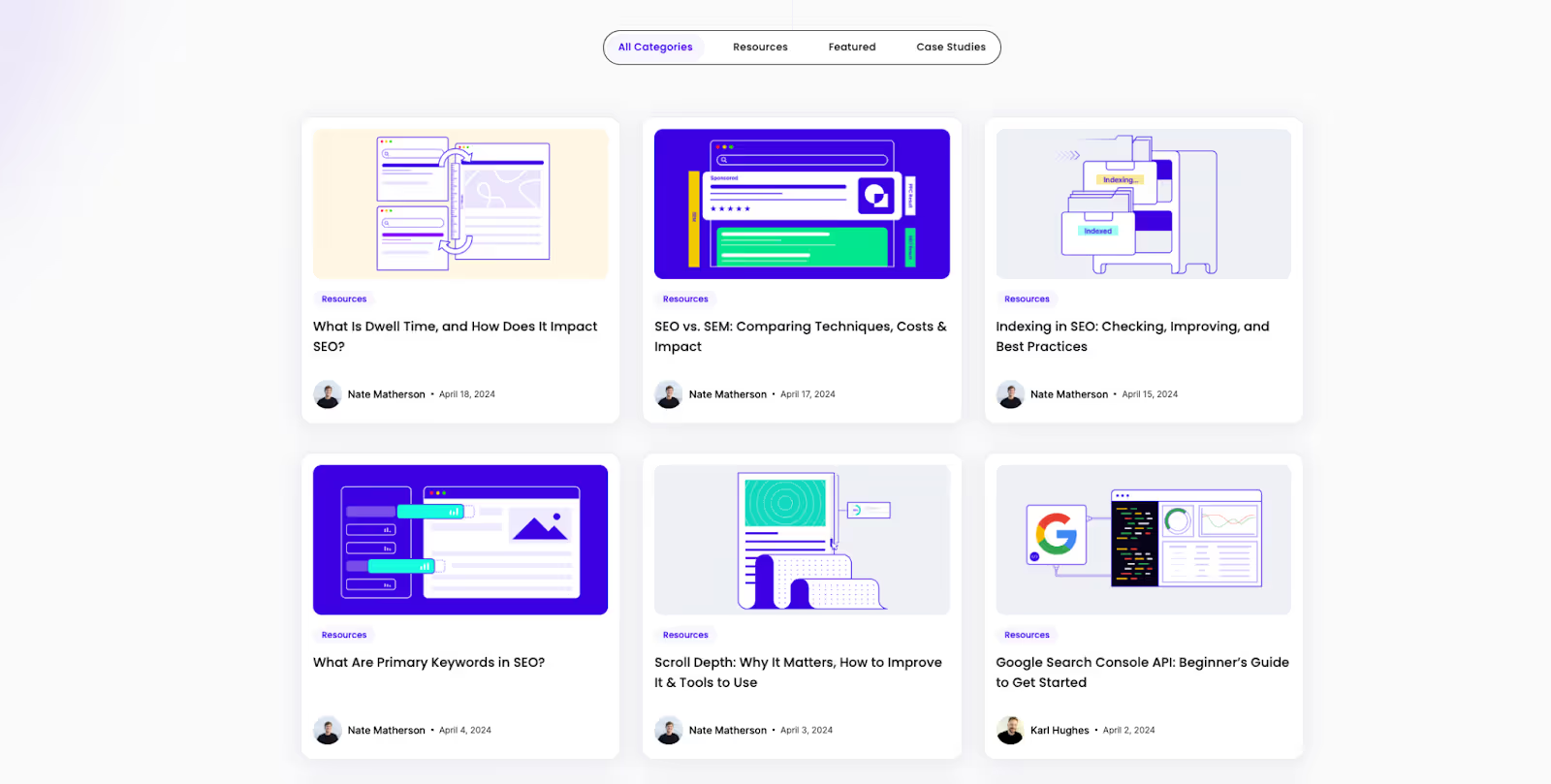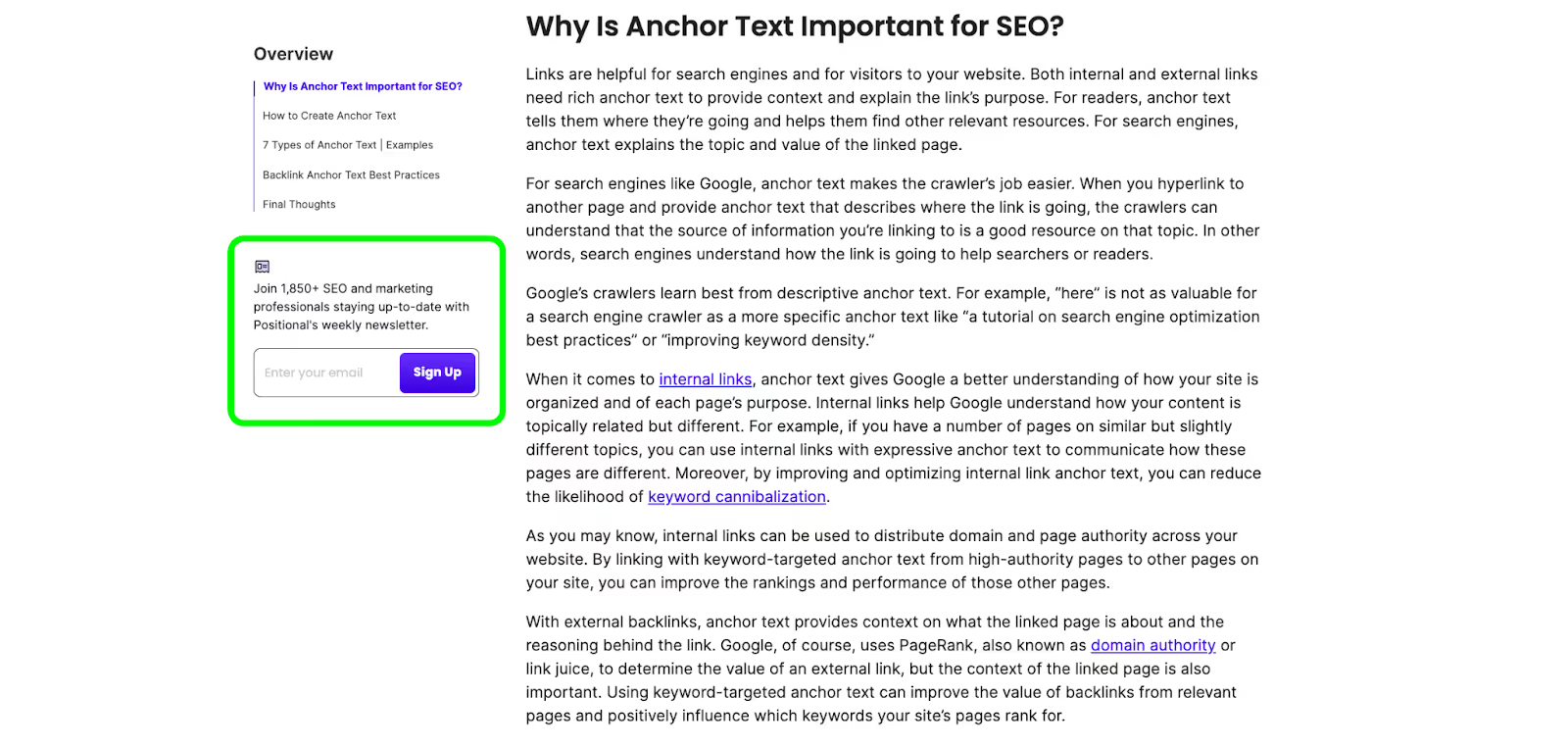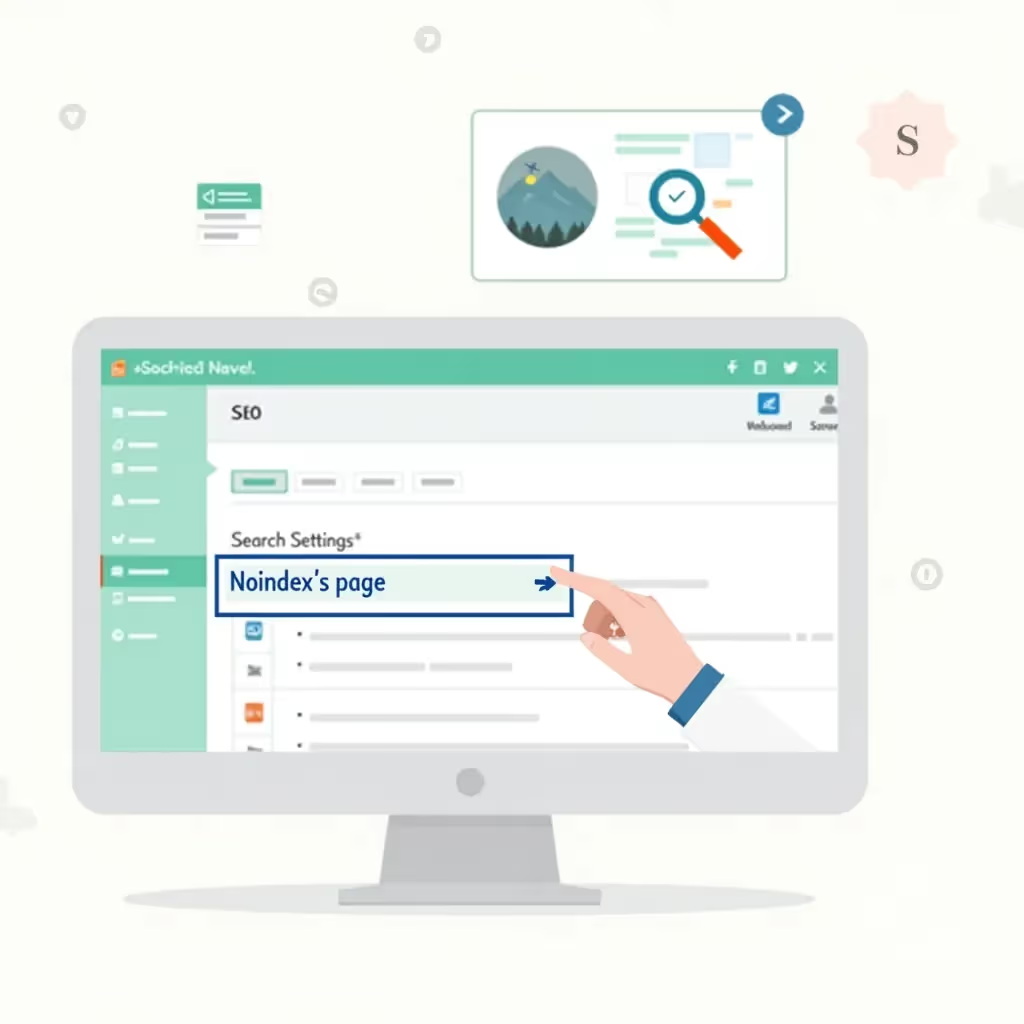Right now, you are reading a business blog.
So our business blogging efforts have obviously worked — because you’ve found us!
This post, just like the others on this blog, was optimized with keywords to maximize the chances that it would rank highly on search engine results pages (SERPs). For example, our H1 and title tags target our primary keywords.
That’s just one SEO tip. And if you’re looking to drive organic traffic and bring customers to your website, you can use all the other techniques we've implemented to get you here, to this one.
This guide will help you learn how to put blogging to work for your business.
What Is Blogging for Business?
Before you start a business blog, it's helpful to know what a blog is.
“Blog” is short for “weblog.” It's basically a special kind of website (or webpage, or section of a website) built on a blogging platform that allows for easy updates. Businesses typically use blogs to share news and insights related to their industry, information about their company or their products, and their leaders’ (and other experts’) thoughts and opinions on topics related to their business.
Blogs typically have a landing page that allows viewers to see all of the blog’s posts (or the most recent ones), often with pictures or graphics. Here’s what the Positional Blog looks like:

5 Key Benefits of Blogging for Business
Business blogging has many potential benefits. Here are five big reasons you might want to start a business blog.
1. You Can Increase Website Traffic
Blogging is one of the best ways to bring more organic traffic to your website. In fact, research published by HubSpot found that companies that blog get 55% more website visitors. And it's easy to see why.
A successful blog gives you more pages for search engines to index. Hubspot has reported that companies with blogs have 434% more indexed pages. And more indexed pages mean that your site shows up in more search results.
Blogging businesses also have 97% more inbound links — that is, links from other websites to their content. Inbound links not only send people directly to your website, but also signal to search engines that your site has domain authority. This increases the chance that your site’s pages will be displayed highly on SERPs.
2. You Can Use Website Traffic to Drive New Customer Acquisition
As many as 70% of consumers learn about businesses through their blogs. Once consumers find your site, you have an opportunity to turn them into customers. And this isn’t just for B2C companies. According to OGM, search engines are still the number one source of information for B2B software buyers.
Business blogging can be a very effective marketing strategy because it allows you to educate potential customers about your products or services. Once you establish yourself as an authority and site visitors begin to engage with your content, they are much likelier to ultimately buy your products or services.
As an example, Wayfair's blog features real homeowners discussing how they use specific furniture pieces. And of course, each blog post includes a link to the product so the target audience can buy the item themselves:

3. You Can Repurpose Blog Content for Other Channels
The blog content you create doesn’t have to end on your blog. You can repurpose it for social media and other digital marketing efforts, including:
- X (formerly Twitter)
- Newsletters
Repurposing content from your blog allows you to engage with people who might not visit your site but who follow you on LinkedIn or X. Since it can take time to see results from your blog as you build up search authority and backlinks to drive traffic, repurposing content can help you acquire customers faster.
Typically, repurposing content involves taking longer-form blog posts (like this one) and breaking out small sections to use for X threads or on LinkedIn.
You can also do the reverse and repurpose content for your blog. For example, you can include excerpts from podcasts in your blog posts. This allows you to get more value from your content.
4. You Can Build Your Brand and Establish Trust
Blogging is also a way to build your brand.
Each blog post you write is another opportunity to talk to your audience and demonstrate your expertise. You can use your blog to develop a brand voice, helping potential customers to better understand your place in your industry (and to better understand how your product or service can benefit them).
Guest blogging and earning links from other trusted industry resources can also ensure that your name stays in front of potential customers. If potential clients frequently see links to your blog or refer to it for information, they're more likely to reach out when they need your services.
5. You Can Create Content That Supports Other Teams
Data has shown that 32% of sales representatives who are empowered with the right sales enablement content are more productive and more likely to reach their quotas.
Blog posts are one of several types of sales enablement content. Your blog posts can help communicate your product’s value. Examples include:
- Blog posts showing how your products work to help customers address pain points.
- Blog posts showcasing customers who have used your products and services to great success (case studies).
- Statistics and studies showcasing the benefits of your product or services
For example, on Positional's blog, there are blog posts showing you how the platform can help you do competitor research. These posts provide clear, real-life examples of how to incorporate our products into a content optimization strategy.
9 Tips to Get Started with Your Business Blog
So are you convinced of the benefits of business blogging and ready to get started? Here's what you need to do to make your blog a success:
1. Set clear goals
You should have well-defined objectives for the business blog you're creating. Those objectives could include:
- Increasing visibility in search engines
- Ranking for specific keywords
- Driving more organic traffic to your blog or website
- Growing your presence on social media channels
- Increasing sales
- Gaining newsletter subscriptions
- Building a customer database by collecting emails
Depending on your goals, there are different metrics you can use to track your success. For example, you can monitor:
- Total blog visits and visits to individual pages
- Average views per post (to identify how different posts contribute to overall traffic)
- Number of inbound links per post (having many high-quality links can show Google that people find your content valuable — and that can lead to better SERP placements)
- Number of social media shares per post (tracking social shares helps you determine what content can be repurposed and what's resonating with readers)
- Sources of traffic, including which keywords and sites are sending visitors to your blog
- Number of comments per post (if comments are turned on) — this is an important measure of user engagement
- Leads and customers generated by your blog (you'll need to use software that allows you to implement closed loop reporting, which tells you where customers came from before they made a purchase or submitted their information)
- Conversion rate, or the rate at which visitors to your site become leads or customers
The more data you collect, the more you can dial into which posts are doing the most to drive organic traffic to your site and to convert visitors into customers.
2. Choose a Platform or Content Management System to Host the Content On
There are many different platforms you can use to host a blog. Some examples are:
- Webflow (Positional’s blog is on Webflow)
- WordPress
- CMS Hub
- Medium
- Weebly
- Wix
- Web.com
- Squarespace
While many of these platforms provide free basic plans, business bloggers typically need a paid plan to get the features and tools they need.
You should focus on finding an affordable platform that offers user-friendly editorial features. Tools such as post-scheduling and domain name certification can be helpful.
Some platforms, such as Wix and Squarespace, also allow you to sell products and can facilitate order fulfillment or digital downloads of paid content.
3. Decide Who Will Produce the Content
Blogs have to contain good content and should be updated regularly. So you'll need to decide who’ll produce the content you're posting.
As Google has refined its search algorithms, content quality has become more important than ever, so having clearly written posts with authoritative bylines is crucial.
You can take one of two approaches: create content in-house or work with freelance writers.
Working with freelancers helps you to scale your content faster. And you can hire people with writing and SEO expertise who can ensure that your posts are optimized for the web.
Not every business owner is a great writer (and many business owners will find that their time is better spent on other tasks), so be honest with yourself about what you’re good at and what your priorities are before deciding whether to write posts yourself or have a staff member or a freelancer write them.
You can hire freelance writers through a variety of websites. However, the quality of the writing can vary, and you may have to try a few writers before you find a good fit. You can also look at who’s writing articles and blogs that you connect with and approach those writers.
I've been a freelance writer for 16 years, and I'm regularly approached on LinkedIn by people who have read my work elsewhere. Around one-third of the time, I end up writing for those who contact me.
Remember, with business blogging, finding the right writers and paying for high-quality writing can help you develop a consistent brand voice. Your writers can stay with you for years and develop a deep knowledge of your company, its products, and its customer base.
4. Create an SEO Strategy
You need an SEO strategy if you want people to find your blog through organic search.
An SEO strategy starts with picking good primary keywords. These are the main keywords or search queries you're trying to rank for with each blog post. The following steps can help you decide which primary keywords to target:
Research Monthly Search Volume
Search volume is the total number of searches for a given phrase each month. Generally, the broader the keyword, the higher the search volume — and the higher the competition will be to rank for it.
It’s usually a good idea to choose a keyword that a substantial number of people are searching for. But you don't want too many pages on your blog or website targeting the same primary keyword. This can cause Google to be confused about which page to rank for that search phrase (and it may end up ranking none of them highly).
Research Keyword Difficulty (Competition)
SEO tools usually show both the number of monthly searches for a particular keyword and its difficulty, a metric that describes the competition of sites targeting the keyword.
The picture below shows Positional's Keyword Research tool displaying data for the keyword "internal linking SEO."

The more competition there is, the tougher it will be to rank. For example, you're very unlikely to be on the first page of Google for the word "lawyer" if you're a new blogger just starting out, as there are simply too many attorneys and legal websites targeting that phrase.
Let Your Competitors Inspire You
See what other companies in your industry are blogging about. You can look to both industry leaders and small businesses who are running successful blogs. This can help you to determine what's resonating with audiences looking for the products or services you provide.
5. Build Quality Content
Once you know what your primary keywords are for each post, it's time to get down to writing.
You'll want to write posts that keep people on the page and give them exactly what they are looking for. In theory, by measuring engagement, Google and other search engines track how people interact with your work.
Quality content should:
- Address the intent of users searching for the keyword.
- Offer a unique perspective. Don't just say the same thing everyone else does.
- Include proper sourcing. Showing where you got your information and using reliable sources helps establish trust.
- Include solid visuals or video. This makes your content more engaging and digestible.
- Be mobile-friendly. Avoid long paragraphs or blocks of text.
The better your content, the more likely readers will share it or link to it, and the more likely you'll develop your brand's authority. Odds are, the more likely they will be to convert into customers, too.
6. Optimize Your Posts
Optimizing your content means using tools and techniques that help make your content more visible, engaging, and effective.
Most people talk about optimization in reference to SEO, but you also want to optimize for the human reader as well. Look at this possible opening paragraph:
Blogging for business is important. A business blog can help you to get more customers, so blogging for business can help you increase your revenue. You should start a business blog and write a new blog post for your business because successful money blogging will bring in blog readers that could become customers.
That paragraph includes a lot of keywords. But does it make you want to keep reading?
A well-optimized blog will appeal to both search engines and readers. That means incorporating keywords naturally, avoiding keyword stuffing, and considering the reader's search intent.
How to Optimize for SEO
You can optimize effectively for SEO while still making great content. To start, always use your primary keyword in header elements (your headings), title tags, meta tags, and URL slugs.
You'll also want to include some secondary or long-tail keywords within your post. Long-tail keywords are the longer, more specific phrases people look for when they’re closer to taking action.
For example, while "Italian restaurants" would be a primary keyword, "cheap Italian restaurants near Disney World," would be a long-tail keyword. The second term has a lower search volume, but it can be easier to rank for — and people searching for it are more likely to come to your Italian restaurant near the theme park.
There are tools that can help you to make sure you're including the right long-tail keywords, based on your primary keyword. They include Positional, MarketMuse, and Clearscope. For example, when you write within Positional's Optimize tool for content optimization, you'll get a score based on how well you used both your primary and secondary keywords.
Positional's tools also score your content based on readability which, again, is also really important because it keeps people on your page.
Optimizing for SERP Features
You may also want to try to optimize your blog post for specific SERP features. For example, Google includes a People Also Ask section on many SERPs. This is a list of questions related to the original search. You can try to write content that will appear as an answer to one of these questions.

Google also serves up a featured snippet for many search queries. A featured snippet is a short summary responding directly to the searcher's query. Writing blogs containing succinct, comprehensive answers to specific questions relevant to your industry can help your content to show up as the featured snippet.
For example, when you search for "who can file for divorce in Tennessee," you'll see this as the featured snippet; it’s from an article I wrote for Forbes Advisor when freelancing for them.

Internal Link Building
Finally, optimizing for SEO involves internally linking new content on your site to old content and linking old content to new content. Internal linking can:
- Help Google and other search engines to better understand how your site is structured.
- Pass authority, or PageRank, from one page to another.
- Make it easier for visitors to your website to find other relevant content of interest.
You'll probably notice that on this page, I included several internal links to other Positional blog posts relevant to the topics I was discussing.
These links signal to search engines that the pages are related, making it easier for Google to discover and index all of the pages. And linking from the existing posts to this page will help Google discover the new posts.
Ideally, you'll want to internally link to your most important pages. This is especially important for new bloggers.
7. Build Some Backlinks
Once you have some great content on your website, it's time to build some backlinks.
Backlinks, or inbound links, are links to your site from other websites. They help people find you, both because they can follow the links directly and because high-quality inbound links tell Google that a page is useful and should show up on SERPs.
There are a number of possible ways to build backlinks, including:
- Guest blogging: This involves writing a post that's published on another website or blog. In your guest post, you'll want to include links to relevant pages on your own site, using targeted anchor text — and even if you can’t do that, the blog should at least link to your site’s home page (for instance).
- Creating link bait: These are pages or posts that many people want to link to. Statistics pages are a good example of link bait. If you create a page of interesting statistics, other websites may cite those statistics and link to the page they came from.
Writing relevant, interesting, topical, and timely content can help encourage other websites to offer you guest posting opportunities or to link to the content you create.
8. Promote Your Content
After you've worked so hard on your content, it's time to promote it.
You can use your social media channels to do that, especially if you have a large following. Social media posts can reach audiences that have already expressed interest in your company.
Repurposing some of your blog content using the tips mentioned above can be helpful. Readers who see snippets of your content on X or LinkedIn may be inspired to visit your blog to read the whole post.
If you have an email newsletter, or want to start one, you can also use it to promote blog content. Include a call-to-action on blog posts that encourages readers to subscribe and receive an email notification when a new post goes up.

This type of digital marketing can help you build a loyal base of readers.
9. Publish New Content Regularly
Blogs are most successful when they have a solid content library and when new posts are added regularly. Exactly how often you'll need to publish new posts depends on your goals, as well as on how old your blog is.
New bloggers often need to post more often to build topical authority and begin ranking for relevant topics. However, Google's focus on E-E-A-T — experience, expertise, authoritativeness, and trustworthiness — means that quality can be more important than quantity.
If you don't have the bandwidth to produce dozens of rich content posts each month, it's best to focus on just a few solid posts targeting your most important keywords.
Start Blogging for Business Today
Now, you have the knowledge and tools necessary to start building a solid business blog and begin reaping the benefits of this content marketing technique. Define your goals, choose your platform, devise your SEO strategy, write some good content, and put up your first post.
Positional is here to help with the tools you’ll need at each step of this process, from keyword research to optimization, so you can make your blog a success.





